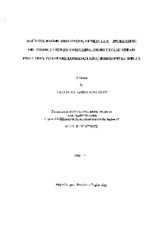| dc.creator | Rodriguez, Manuel Gregorio | |
| dc.date.accessioned | 2012-06-07T22:57:24Z | |
| dc.date.available | 2012-06-07T22:57:24Z | |
| dc.date.created | 1999 | |
| dc.date.issued | 1999 | |
| dc.identifier.uri | https://hdl.handle.net/1969.1/ETD-TAMU-1999-THESIS-R635 | |
| dc.description | Due to the character of the original source materials and the nature of batch digitization, quality control issues may be present in this document. Please report any quality issues you encounter to digital@library.tamu.edu, referencing the URI of the item. | en |
| dc.description | Includes bibliographical references (leaves 124-128). | en |
| dc.description | Issued also on microfiche from Lange Micrographics. | en |
| dc.description.abstract | The Bachaquero-01 reservoir of the Lagunillas field is located in the eastern part of the Maracaibo Lake, Venezuela. The field is operated by the national oil company of Venezuela, PDVSA (Petroleos de Venezuela, S.A.). The Bachaquero-01 heavy oil reservoir lies at about 3,000 ft. ss. and contains 7.037 BSTB of 1 1.7 degrees API gravity oil with an in-situ viscosity of 635 cp. Cold production began in 1960, but since 1971 the reservoir was produced under a massive cyclic steam injection system. To-date some 370 cyclic-steam injection welts have produced from the reservoir, yielding a cumulative oil recovery of only about 5.6% of initial oil-in-place. The reservoir pressure has dropped from an initial 1,370 psia to its present value of about 700 psia. Maximum oil production peaked at 45.0 MSTB/D in 1991, and has since continued to decline. To arrest production decline, three horizontal cyclic-steam injection wells were drilled and completed in the reservoir in 1995-1997. The horizontal sections were from 1,280 to 1,560 ft long and were drilled in locations with existing vertical cyclic steam injection welts. Three-dimensional thermal-compositional simulation studies were conducted to evaluate the performance of the three horizontal welts under cyclic steam injection and steamflooding. The Cartesian model dimensions of the three horizontal welts were 11x22x4, 11x27x5, and 12x20x5. In the steamflooding scheme investigated, the existing horizontal welts were used as injectors while existing (and new) vertical welts surrounding the horizontal welts were used as producers. Simulation results indicate oil recovery under cyclic steam injection to be about 15% of initial oil-in-place, compared to about 25% under steamflooding with no new producers, and about 50% under steamflooding with additional producers. The main advantages of steamflooding over cyclic steam injection were in the re-pressurization and improved thermal efficiency for the Bachaquero-01 reservoir. Higher oil recovery with additional wells resulted from improved areal sweep efficiency. Further study is planned to investigate steamflooding for the rest of the reservoir. | en |
| dc.format.medium | electronic | en |
| dc.format.mimetype | application/pdf | |
| dc.language.iso | en_US | |
| dc.publisher | Texas A&M University | |
| dc.rights | This thesis was part of a retrospective digitization project authorized by the Texas A&M University Libraries in 2008. Copyright remains vested with the author(s). It is the user's responsibility to secure permission from the copyright holder(s) for re-use of the work beyond the provision of Fair Use. | en |
| dc.subject | petroleum engineering. | en |
| dc.subject | Major petroleum engineering. | en |
| dc.title | Bachaquero-01 reservoir, Venezuela-increasing oil production by switching from cyclic steam injection to steamflooding using horizontal wells | en |
| dc.type | Thesis | en |
| thesis.degree.discipline | petroleum engineering | en |
| thesis.degree.name | M.S. | en |
| thesis.degree.level | Masters | en |
| dc.type.genre | thesis | en |
| dc.type.material | text | en |
| dc.format.digitalOrigin | reformatted digital | en |


